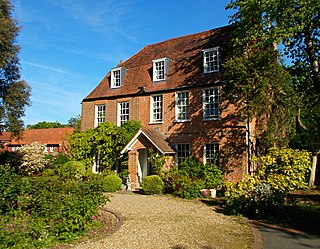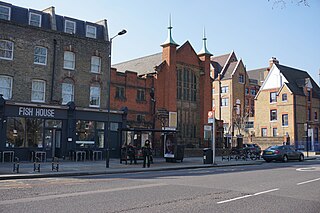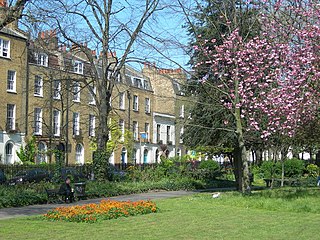
Cheam is a suburb of London, England, 10.9 miles (17.5 km) southwest of Charing Cross. It is divided into North Cheam, Cheam Village and South Cheam. Cheam Village contains the listed buildings Lumley Chapel and the 16th-century Whitehall. It is adjacent to two large parks, Nonsuch Park and Cheam Park. Nonsuch Park contains the listed Nonsuch Mansion. Parts of Cheam Park and Cheam Village are in a conservation area. Cheam is bordered by Worcester Park to the northwest, Morden to the northeast, Sutton to the east, Epsom, Ewell and Stoneleigh to the west and Banstead and Belmont to the south.

The London Borough of Hackney is a London borough in Inner London, England. The historical and administrative heart of Hackney is Mare Street, which lies 5 miles (8 km) north-east of Charing Cross. The borough is named after Hackney, its principal district. Southern and eastern parts of the borough are popularly regarded as being part of east London that spans some of the traditional East End of London with the northwest belonging to north London. Its population is estimated to be 281,120.

Homerton is an area in London, England, in the London Borough of Hackney. It is bordered to the west by Hackney Central, to the north by Lower Clapton, in the east by Hackney Wick, Leyton and by South Hackney to the south. In 2019, it had a population of 14,658 people. In terms of ethnicity it was 43.9% White, 33.0% Black, 10.9% Asian and 7.8% Mixed. It covered an area of 0.830 sq kilometres. Homerton ward on Hackney Borough Council is currently represented by three Labour councillors. There are fifty listed buildings located within the boundaries of the ward.

The London Borough of Sutton is an Outer London borough in London, England. It covers an area of 43 km2 (17 sq mi) and is the 80th largest local authority in England by population. It borders the London Borough of Croydon to the east, the London Borough of Merton to the north and the Royal Borough of Kingston upon Thames to the north-west; it also borders the Surrey boroughs of Epsom and Ewell to the west and Reigate and Banstead to the south. The local authority is Sutton London Borough Council. Its principal town is Sutton.

The Worshipful Company of Grocers is one of the 111 livery companies of the City of London, ranking second in order of precedence.

Bromley, commonly known as Bromley-by-Bow, is a district in the London Borough of Tower Hamlets in East London, located on the western banks of the River Lea, in the Lower Lea Valley in East London.

Homerton College is a constituent college of the University of Cambridge. Its first premises were acquired in Homerton, London in 1768, by an informal gathering of Protestant dissenters with origins in the seventeenth century. In 1894, the college moved from Homerton High Street, Hackney, London, to Cambridge. Homerton was admitted as an "Approved Society" of the university in 1976, and received its Royal charter in 2010, affirming its status as a full college of the university. The college celebrated its 250th anniversary in 2018.

Sir Ralph Sadler or Sadleir PC, Knight banneret was an English statesman, who served Henry VIII as Privy Councillor, Secretary of State and ambassador to Scotland. Sadler went on to serve Edward VI. Having signed the device settling the crown on Jane Grey in 1553, he was obliged to retire to his estates during the reign of Mary I. Sadler was restored to royal favour during the reign of Elizabeth I, serving as a Privy Councillor and once again participating in Anglo-Scottish diplomacy. He was appointed Chancellor of the Duchy of Lancaster in May 1568.

Thomas Sutton was an English civil servant and businessman, born in Knaith, Lincolnshire. He is remembered as the founder of the London Charterhouse and of Charterhouse School.

Homerton is a station on the North London line in the district of Homerton, East London. The station and all trains serving it are operated by London Overground. It is in London fare zone 2. The current station opened on 13 May 1985 to coincide with the introduction of the Richmond to North Woolwich through electric passenger service. The station is close to Homerton University Hospital and Hackney Marshes.

The Tudor architectural style is the final development of medieval architecture in England and Wales, during the Tudor period (1485–1603) and even beyond, and also the tentative introduction of Renaissance architecture to Britain. It followed the Late Gothic Perpendicular style and, gradually, it evolved into an aesthetic more consistent with trends already in motion on the continent, evidenced by other nations already having the Northern Renaissance underway Italy, and especially France already well into its revolution in art, architecture, and thought. A subtype of Tudor architecture is Elizabethan architecture, from about 1560 to 1600, which has continuity with the subsequent Jacobean architecture in the early Stuart period.

Hackney Central is a sub-district of Hackney in the London Borough of Hackney in London, England and is four miles (6.4 km) northeast of Charing Cross.

South Hackney is an area in London, England and is located in the London Borough of Hackney. It is in East London and part of the East End. It is about 4.2 mi (6.8 km) northeast of Charing Cross.

Sutton Place, is a small street in the London Borough of Hackney. It links Homerton High Street with St John's Church Gardens, in Hackney. The Georgian terrace of 1790–1806, is Grade II listed as a whole, together with the villas on the north side of the street which date from 1820, and is sited in the conservation area around the gardens of St John-at-Hackney. The street replaced Church Path, an historic path connecting the villages of Homerton and Hackney.

Clapton Square is the second largest garden square in the London Borough of Hackney, located in Lower Clapton, Clapton. It is lined by buildings on three sides. Its Conservation Area designated in 1969 – extended in 1991 and 2000 – takes in a larger green space separated by a stretch of open road: St John's Gardens. Those gardens have the tallest and largest building visible from all parts of the square's garden, the Church of St John-at-Hackney, rebuilt in 1792-97 which contains older monuments. Two sides of the square are lined with tall, partly stone-dressed, classical, Georgian terraced houses.

St John at Hackney is a Grade II* listed Anglican Church in the heart of the London Borough of Hackney with a large capacity of around 2,000. It was built in 1792 to replace Hackney's medieval parish church, of which St Augustine's Tower remains, at the edge of its churchyard. The church faces north towards Clapton Square, with the nearby Sutton House and Hackney Central station also accessible from the churchyard to the east and south, respectively. As well as a thriving parish church, St John at Hackney has also become known as a notable music venue, playing host to the likes of Coldplay, Ed Sheeran, Emeli Sande, Robbie Williams, Griff and Interpol.
Sutton House may refer to:
The Gravel Pit Chapel was established in 1715–1716 in Hackney, then just outside London, for a Nonconformist congregation, which by the early 19th century began to identify itself as Unitarian. In 1809 the congregation moved to the New Gravel Pit Chapel nearby, while its old premises were taken over by Congregationalists. The New Gravel Pit Chapel was closed and demolished in1969.

Homerton University Hospital is a teaching hospital in Homerton in the London Borough of Hackney. It is managed by Homerton University Hospital NHS Foundation Trust.

Hackney is a district in East London, England, forming around two-thirds of the area of the modern London Borough of Hackney, to which it gives its name. It is 4 miles (6.4 km) northeast of Charing Cross and includes part of the Queen Elizabeth Olympic Park. Historically it was within the county of Middlesex.
























